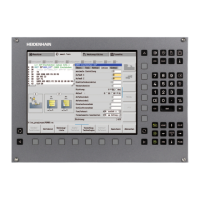626 HEIDENHAIN Technical Manual MANUALplus 620
6.3.1 Axis designations and coordinates
Principal, parallel and rotary axes are distinguished.
Properties of the
principal axes
X, Y, Z
X, Y and Z axes are principal axes. These axes have a defined spatial
orientation in a coordinate system model, and are always linear.
It is of no importance to the editor whether the current coordinate system is
that of the machine base system, or is aligned otherwise.
They are the principal coordinates for programming in the editor.
An easy way to remember this system is to use the "right-hand rule":
Algebraic signs of
the axes
When the programmer writes an NC program, he always assumes that the
tool (not the workpiece) is in motion. If the machine moves its workpiece
holding element (spindle with C axis) in a particular axis instead of the tool,
then the direction of actual motion is opposite to the direction of axis motion.
In this case the direction of motion is designated with the same algebraic sign
as the axis direction, but with an apostrophe: +X´, +Y´ and +Z´
Properties of the
rotary axis C
For the rotary axis C, the turning axis is in the direction of the principal
coordinate Z. The C axis is therefore a "parallel" rotary axis. The direction of the
rotary axis C follows the "right-fist rule." The fingers of the closed right hand
point in the proper rotation direction of an axis when the thumb points in the
direction of the associated linear axis Z. The angle values of the C axis are
given with respect to the zero point of the C axis.
+X
+Y
+Z

